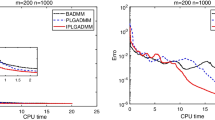Abstract
In order to solve a quadratic 0/1 problem, some techniques, consisting in deriving a linear integer formulation, are used. Those techniques, called “linearization”, usually involve a huge number of additional variables. As a consequence, the exact resolution of the linear model is, in general, very difficult.
Our aim, in this paper, is to propose “economical” linear models. Starting from an existing linearization (typically the so-called “classical linearization”), we find a new linearization with fewer variables. The resulting model is called “Miniaturized” linearization. Based on this approach, we propose a new linearization scheme for which numerical tests have been performed.
Similar content being viewed by others
References
Adams, W., A. Billionnet, and A. Sutter. (1990). “Unconstrained 0-1 Optimization and Lagrangean Relaxation.” Discrete Applied Mathematics 29, 131–142.
Alidaee, B., G. Kochenberger, and A. Ahmadian. (1994). “0-1 Quadratic Programming Approach for the Optimal Solution of Two Scheduling Problems.” International Journal of System Science 25, 401–408.
Beasley, J.E. (1998). “Heuristic Algorithms for the Unconstrained Binary Quadratic Programming Problem.” Technical report, Department of Mathematics, Imperial College of Science and Technology, London, England.
Balas, E. and J.B. Mazzola. (1984). “Non-Linear 0-1 Programming i : Linearization Techniques.” Mathematical Programming 30, 1–21.
Billionnet, A. and A. Sutter. (1994). “Minimization of a Quadratic Pseudo-Boolean Function.” European Journal of Operational Research 78, 106–115.
Chang, C.T. and C.C. Chang. (2000). “A Linearization Method for Mixed 0-1 Polynomial Programs.” Computers and Operations Research 27, 1005–1016.
Chardaire, P. and A. Sutter. (1995). “A Decomposition method for Quadratic Zero-One Programming.” Management Science 41(4), 704–712.
Djabali, R. (1998). Optimisation non linéaire en variables bivalentes et applications. Thèse de doctorat, CNAM.
Deza, M. and M. Laurent. (1992a). “Facets for the Cut Cone I.” Mathematical Programming 56(2), 121–160.
Deza, M. and M. Laurent. (1992b). “Facets for the Cut Cone II.” Mathematical Programming 56(2), 161–188.
Fiduccia, C. and R. Mattheyses. (1982). “A Linear-Time Heuristic for Improving Network Partitions.” In ACM/IEEE 19th Design Autom. Conference, Las Vegas, 175–181.
Fortet, R. (1959). “L'algèbre De Boole et ses Applications En Recherche Opérationnelle.” Cahier du Centre d'Etudes de Recherche Opérationnelle 1, 5–36.
Fortet, R. (1960). “Application De L'algèbre De Boole En Recherche Opérationnelle.” Revue Française de Recherche Opérationnelle 4, 17–26.
Garey, M. and D. Johnson. (1979). Computers and Intractibility: A Guide to the Theory of NP-Completeness. W.H. Freeman & Company.
Glover, F., G.A. Kochenberger, and B. Alidaee. (1998). “Adaptative Memory Tabu Search for Binary Quadratic Programs.” Management Science 44, 336–345.
Glover, F. (1975). “Improved Linear Integer Programming Formulations of Nonlinear Integer Problems.” Management Science 22(4), 455–460.
Gueye, S. (2002). Linéarisation et relaxation lagrangienne pour problèmes quadratiques en variables binaires. Thèse de doctorat, Université d'Avignon.
Helmberg, C. and F. Rendl. (1998). “Solving Quadratic (0,1)-Problems by Semidefinite Programs and Cutting Planes.” Mathematical Programming 82(3), 291–315.
Johnson, D., C. Aragon, L. McGeoch, and C. Schevon. (1989). “Optimization by Simulated Annealing: An Experimental Evaluation: Part i, Graph Partitioning.” Operations Research 37, 865–892.
Kumar, V., A. Grama, A. Gupta, and G. Karypis. (1994). Introduction to parallel computing: design and analysis of algorithms. Benjamin/Cummings Publishing Company, Redwood City, CA.
Kernighan, B.W. and S. Lin. (1970). “An Efficient Heuristic Procedure for Partitioning Graphs.” Bell Systems Technical Journal 49, 291–307.
Kuznar, R. (1996). Partitioning and optimization of digital integrated circuits. Doctoral thesis, University of Ljubljana, Faculty of Electrical Engineering, Ljubljana, Slovenia.
Lodi, A., K. Allemand, and T.M. Liebling. (1999). “An Evolutionary Heuristic for Quadratic 0-1 Programming.” European Journal of Operational Research 119, 662–670.
Laguna, M., T.A. Feo, and H.C. Herold. (1994). “A Greedy Randomized Adaptive Search Procedure for the Two-Partition Problem.” Operations Research 42(4), 677–687.
Merz, P. and B. Freisleben (2002). “Greedy and Local Search Heuristics for Unconstrained Quadratic Programming.” Journal of Heuristics 8(2), 197–213.
Michelon, P. (1992). “Unconstrained Non-Linear 0-1 Programming: A Non differentiable Approach.” The Journal of Global Optimization 2, 155–165.
Michelon, P., S. Ripeau, and N. Maculan. (1995). “Un Algorithme pour La Bipartition D'un Graphe En Sous Graphes De Cardinalité fixée.” In FRANCORO I.
Padberg, M. (1989). “The Boolean Quadric Polytope: Some Characteristics, Facets and Relatives.” Mathematical Programming 45, 139–172.
Poljak, S., F. Rendl, and H. Wolkowicz. (1995). “A Recipe for Semidefinite relaxation for (0,1)-Quadratic Programming.” Journal of Global Optimization 7(1), 51–73.
Rolland E. and H. Pirkul. (1992). “Heuristic Solution Procedures for the Graph Partitioning Problem.” In S. Zenios, O. Balci, and R. Sharda (eds.), Computer Science and Operations Research: New Developments in their Interfaces. Pergamon Press, Oxford.
Sherali, H.D. and W.P. Adams. (1999). A Reformulation Linearization Technique for Solving Discrete and Continous Nonconvex Problems. Kluwer Academic Publishers.
De Simone, C. (1989). “The Cut Polytope and Boolean Quadric Polytope.” Discrete Mathematics 79, 71–75.
Soutif, E. (2000). Résolution du problème quadratique en variables bivalentes. Thèse de doctorat, CNAM.
Author information
Authors and Affiliations
Corresponding author
Rights and permissions
About this article
Cite this article
Gueye, S., Michelon, P. “Miniaturized” Linearizations for Quadratic 0/1 Problems. Ann Oper Res 140, 235–261 (2005). https://doi.org/10.1007/s10479-005-3973-5
Issue Date:
DOI: https://doi.org/10.1007/s10479-005-3973-5




